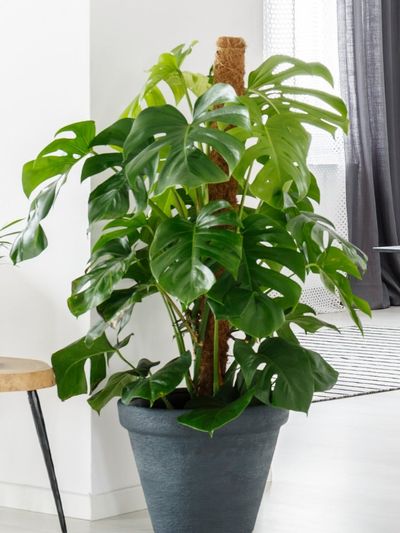How to Make a Moss Pole Plant Support
Cheese plants are epiphytes, which means they are vertically growing plants that use the support of other plants in their environment. This means that training cheese plant on a moss pole perfectly mimics their natural state. Using moss poles for cheese plants creates the environment Monstera needs to raise the heavy stem upright and provides a pleasing appearance. You will need a stout stake a little bit taller than the plant. Use wire snips and cut a piece of fine mesh wire just large enough to go around the stake. Wood staples work well to attach the hoop of wire mesh around the wooden stake. To finish this support for cheese plant, use soaked sphagnum moss. Fill in around the stake with the moss, pushing it into the mesh. You can also make a Monstera moss pole without the stake and simply fill a tube made of mesh with the moss and fix the edges together, but I feel like the stake adds to the stability. Some philodendron stems get quite large and heavy.
Training Cheese Plant on a Moss Pole
Using moss poles for cheese plants is an excellent and attractive way to give the climber the scaffold it needs for natural vertical growth. Without the support, the thick stems would end up bending over the sides of the pot and eventually trailing on the floor. This can be damaging to the stems, as the weight of an adult plant will put strain on the untrained branches. The sturdiest situation will result if you insert the Monstera moss pole into the soil at potting. Push the pole all the way to the bottom of the container and snuggle the plant in close, then fill in with potting soil. Training is necessary to keep the upright habit. This is easy to do with plant ties as the philodendron stems get longer. Usually, you will only have to train it two or three times a year to keep new growth in line.
Regular Cheese Plant Maintenance
Regular maintenance of your Monstera cheese plant will provide the best results.
Mist the moss on the pole regularly. This will encourage the aerial roots to attach to the mesh and encourage the vertical growth. Repot the plant every three years using a peat-based potting soil. The support for cheese plant may need to be increased in size at each re-potting. Some indoor gardeners even use eyehooks or plant hooks in the ceiling as the cheese plant matures. Position your Monstera in bright light but avoid full sun and the scorching rays of mid-day. Water thoroughly at irrigation and let water drain from the holes in the bottom of the pot. Then remove any standing water to avoid sodden roots.
This is a long lived plant that will provide you with beautifully configured glossy leaves for decades with proper care.
